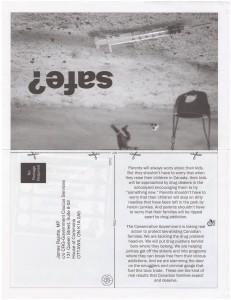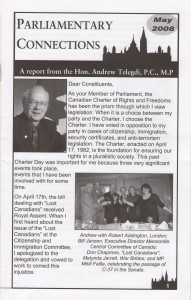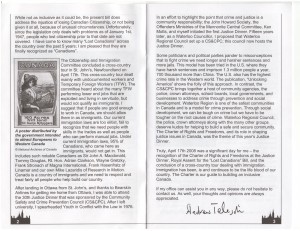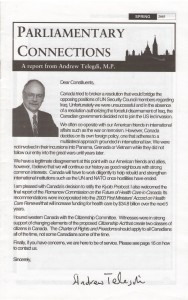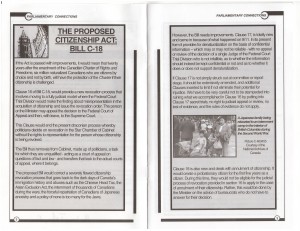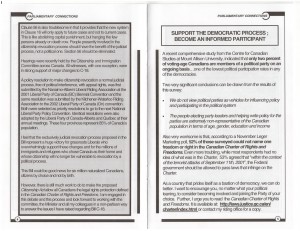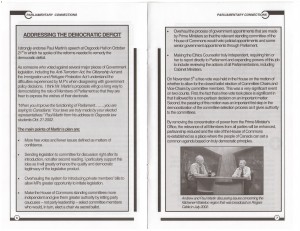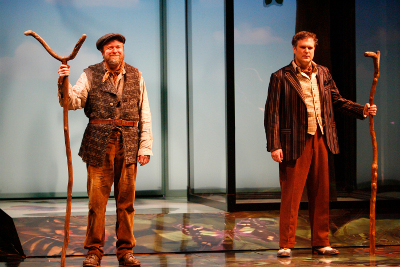Why I am voting for Diane Freeman in the Waterloo Riding in the 2015 Canadian Federal Election
I have never voted NDP in a federal election before. On October 19, 2015, I will be voting for the NDP candidate in my riding of Waterloo, Diane Freeman. She is the best candidate. I would be delighted if she becomes my MP.
I’ll go over my reasons for voting for her, and also what I think of the other local candidates.
First, I’ll tell you a story about her.
I have had the opportunity to watch Diane Freeman in action when I’ve attended Waterloo City Council meetings. I’ve been impressed at the questions she asks, and how informed she is about each decision that comes up.
In one such meeting, a former city councillor who had been involved in the RIM Park scandal was making a comment on the topic of the meeting, when as part of his comment he asserted that city councillors don’t actually read the contracts that they sign as a matter of course. They rely on staff to tell them what the contracts mean.
Diane Freeman said that she reads every single contract that comes before this council. A few other councillors said the same thing, I think Karen Scian was one of them.
I think that if Diane Freeman was my MP, she would actually read every single piece of legislation that she voted on. Do you know how rare that is in a politician? Especially one in federal politics?
Diane Freeman cares deeply about our community. I can tell from all of the things she does. Her actions speak volumes. She goes above and beyond to make this city a better place, and she is smart about it. Not only that, she helps make the people around her smarter about it too. Her questions in city council bring out information that clarifies the situation, and helps everyone make better decisions.
The quality of her work is leaps and bounds beyond anything the other candidates have to offer. The other candidates care for our community too. We are lucky to have a choice between candidates who are involved in our community and care about it! But Diane Freeman is someone special, and I want her to be my MP so much! It would be so good for our community.
I think that with Diane Freeman as MP, we would not simply have a cog in a party machine, but a person who thinks carefully about everything, who pays attention to the details, and who will advocate strongly to do things in a better way than the first idea that is proposed. She’s not afraid to do things herself to understand them, like when she cycles all over the city to understand cycling issues. She listens really well. She delves into things. I doubt we would have a situation where she would defend some stupid party policy just because the party said so. People have to make compromises to be in federal politics, but I think she would keep her integrity. I have been observing how she behaves for years, and this is my assessment of her character.
And now, on to the other local candidates.
Bardish Chagger, candidate for the Liberal Party of Canada
I know the exact moment when Bardish Chagger lost my vote. Mind you, she hadn’t won it yet, but I was considering voting for her.
Shortly after Bill C-51 was passed by the House of Commons, I sent her an email asking her how she would have voted if she had been my MP at the time.
She didn’t reply. I can only assume that she would have voted in the same way as every single other Liberal MP, and voted for the legislation.
At least the incumbent, Peter Braid, gives me the courtesy of a reply.
It’s not just that. Though Bill C-51 is a huge issue for me.
I think Bardish Chagger cares about the community, and she pays lip service to some of the things I care about. But would she stand up for them, even when her party leader was urging her to vote against them? I’ve seen nothing from her that would indicate that she would do anything that would go against the party whip when voting on legislation.
I suppose I would prefer someone who votes with the Liberal party all the time to someone who votes with the Conservative party all the time on legislation, considering what the Conservative party has done in the past few years. But…it’s still not what I would like from a political representative.
Richard Walsh, candidate for the Green Party of Canada
Like the other candidates, I think Richard Walsh cares about this community.
However, some of the comments he has made about the economy indicate that his views and mine do not mesh.
He oversimplifies things too much when talking about the issues. I have the impression that he talks more than he listens, so I am skeptical that he would do as good a job as the other candidates at listening to and representing our community.
On the other hand, he was a leader of the local Stop Bill C-51 rally, which is an issue that I care about.
Peter Braid, candidate for the Conservative Party of Canada
Peter Braid is the only one of the candidates who has actually done the job of MP. So I have a track record to evaluate him on.
If I had to evaluate him based solely on his staff, he would get my highest respect. Every time I have written a letter to him, I have been impressed by the interactions I have had with them. I rarely get a form letter in reply, and when they don’t know much about an issue, they ask questions and take the time to get a better understanding of my point of view. They have been courteous, polite, and nuanced in their interactions with me.
I wish this extended to Peter Braid’s public communications. Alas, he is part of a party that strictly controls what is said in public, lest there be any possibility of any information that may contradict their script. Eek!
More on his public communication style in a bit.
Peter Braid seems like a decent human being. He seems to care about our community. There are things I like about him. I think he is in public life because he wants to make things better.
The one private members bill he wrote and got passed was about making donations to charity easier. A goal I support, though it is admittedly non-controversial.
He has also voted in favour of things that I care about. There are good things that this Conservative government has done that he has been a part of.
Some noteworthy ones are:
- passing the Lyme disease conference legislation
- untying foreign aid, so that Canadian companies aren’t favoured in our aid to developing countries
- voting in favour of the Reform Act, to make it so that the party leader does not have to approve each candidate in a party, and to limit some of the power of the Prime Minister’s office
- support for open data in government
There are also some policies of this government that I think have gotten some undeserved negative press. For example the Tax-free Savings Accounts are often criticized as being only good for the rich, but they also provide benefits similar to an RRSP to some of the most vulnerable in our society, including disabled people who can’t work and aren’t eligible for RRSPs.
Even so, these positive points are outweighed by other problemmatic legislation that he has helped pass. But I thought I’d mention them. There are some ways in which Peter Braid has been a good MP.
I do not like Peter Braid’s approach to communicating with his constituents by newsletter.
Andrew Telegdi was my MP prior to Peter Braid, and he had a much better approach to newsletters.
When Andrew Telegdi was my MP, he sent frequent newsletter where he talked about what he was doing in Ottawa, what he felt about it, and why he was taking the stance he was taking. I felt like I really got to know him. When he took a stand against the Patriot Act, he wrote a long letter explaining why. When he did work on the Citizenship and Immigration committee, he talked about the issues that came up at the committee, and what he thought was the right thing to do.
I felt like I had a window into what he was doing in Ottawa, and why, and that he was open to hearing about the topics he was working on from the community.
When Peter Braid was on a committee looking at Intellectual Property and Copyright, I didn’t hear about it from him at all. The only way I know about it is that I was reading articles online. He didn’t even bother to mention it to his constituents. Never mind solicit our opinions on it. I have no idea what he was thinking at the time, or why he made the decisions he did.
Peter Braid’s newsletters mostly consist federal infrastructure funding announcements and photo ops. I like infrastructure funding announcements, but I expect more from my MP than that.
I’ve also received some nasty psy-ops style flyers that pretend to solicit my opinion, but make it clear that they don’t give a whit what I think, and the purpose of asking the question is to attempt to subtly propagandize.
Just before the election where Peter Braid first got elected, and for a while afterward, I received a bunch of such flyers that said “Who is on the right track…[regarding topic X]?” and had the names of the party leaders and a little arrow pointing to Stephen Harper next to the words “Check one” in a faux-handwriting font. Some of them ostensibly came from other Conservative MPs, because they were using a loophole to avoid spending limits.
I’ve scanned some of these flyers in, so you can see for yourself. I’ve also scanned in the first few pages of some of Andrew Telegdi’s newsletters so you can see how different they were. Click on any of the thumbnail pictures to see a large version.
Flyers from Peter Braid and other Conservative MPs who mailed flyers to my riding
Telegdi’s newsletters from 2003 and 2008
Even if Peter Braid wanted to write letters similar to what Andrew Telegdi wrote, I doubt the Conservative party, as it is today, would let him send them. We used to have a tradition in Canada of public debate, of many different voices in the public sphere. Yes, they occasionally embarrassed the government, but I think that was a good thing. The muzzle approach to public office and public service has taken away something that was special and beautiful about Canadian society.
I’ll go back to talking about legislation, instead of communication styles.
Sometimes people who are otherwise decent people do terrible things. Peter Braid has done terrible things. As has every other Conservative MP in this government. Stephen Harper did not do them alone. Every time a vote came up in the House of Commons, each MP decided how to vote.
What terrible things? Most recently, voting in favour of Bill C-51 and Bill C-24.
In my opinion, voting in favour of Bill C-51 is enough that he should lose his seat.
There are more reasons, but I will start with that.
Bill C-51 creates a secret court that has the power to strip anyone of all of their rights under the Charter of Rights and Freedoms.
That means that the government can decide, at any time, to violate your rights. The secret court gives it a veneer of legitimacy.
A secret court is effectively the same thing as no court at all. The FISA court in the United States approved almost all requests from the government. It acted not like a court, but as a rubber stamp for abuses of power.
I have been following the developments in the Arab Spring. It has given me a perspective that I didn’t have before about what it means to have civil rights. I will share some of it with you.
In August of 2013, I saw photos of young men in Egypt writing their names on their arms with markers, so that if they were killed during the protests, someone would be able to identify their bodies. This was just before the massacre at Rabaa where police killed hundreds of civilians who had gathered to protest actions by the government. After the massacre, the nearby hospital was ordered to stop reporting the number of casualties by the health ministry after the number reached about 500. I saw the photos of the bodies with gunshot wounds to the head. Near Rabaa, there were makeshift medical facilities and morgues….which the police then came back and set on fire. The young men who had written their names on their arms became difficult to identify after all. Their bodies were burned to a crisp. I saw the photos of the blackened bodies, the form recognizable, but the details charred. I saw the photos of the families walking through the burned out makeshift morgue, searching for their dead.
I do not want this to happen in Canada. I do not want this to EVER happen in Canada. Or anywhere else in the world, for that matter, but it is too late for that.
What stops this from happening in Canada? The very systems and safeguards that the Conservative government has started to destroy.
This is the type of thing that happens when you have a secret police that is accountable to no one. This what happens when you think of groups of people that disagree with you as targets to be removed or destroyed “for security”.
Bill C-24 makes it possible to strip people of their Canadian citizenship, if they are eligible to be a dual citizen.
Canada has a track record of what we do to people who don’t have the rights that come with Canadian citizenship. We hold them in solitary confinement for years without charges, without letting them see the evidence against them, or else we deport them to be tortured in another country. Just ask the Secret Trial 5.
I don’t want this to happen to my friends who happen to have been born in another country, or whose parents were born in another country, but who have been Canadian citizens for decades, living peacefully here.
The Trans-Pacific Partnership (TPP) trade agreement is secret. There was not a public debate about it, even though Stephen Harper criticized the previous Liberal government for signing the Kyoto Protocol without a public debate. Some sections of the TPP have been leaked, and they show that this is not a free-trade agreement, but a protectionist trade agreement. Also, that the “freedom to tinker” which is not on the Canadian Charter of Rights and Freedoms, but perhaps should be, will be taken away. In essence, the new rules will make it illegal to take apart something you own to see how it works, if it happens to have digital or software parts to it. The TPP was agreed to by Stephen Harper during this very election campaign, not in a session of parliament. I hope that when parliament reconvenes, it does not ratify the agreement.
Democracy isn’t just some sad ritual we go through every few years to decide who is going to oppress us for this term of office. It also consists of civil society and institutions that help us live in harmony with one another and respect each other’s rights. Those rights shouldn’t be taken away on the whim of a government minister, or a CSIS or RCMP agent, or a suspicion of terrorism, or any other reason.
I love Canada. I do not want it to become a totalitarian police state like Egypt, or a surveillance society like East Germany. If the recently passed legislation is not repealed, and the TPP not stopped, that’s where we’re headed. It’s a devastating future to contemplate.
I’ll get back to the main topic of this blog post, which is evaluating the local candidates in the Waterloo riding of the 2015 Canadian federal election.
Ordinarily, at this point, I might say something like “If you like what the Conservatives have been doing, then Peter Braid is not a bad choice”. You only have to look at the nearby riding of Kitchener Centre to see that it could be worse.
But these are not ordinary times. Instead, I will say this:
Do you value living in a democracy?
If you have children, do you want them to grow up in a democracy?
Do rights like the freedom to assemble, or freedom of expression, mean anything to you?
If someone you loved got arrested, would you like them to be able to see the evidence against them?
Do you think the government should create a surveillance state like East Germany to spy upon its own citizens?
Do you know anyone who was not born in Canada? Do you want them to be second-class citizens without any rights?
What would you think of a government that burned books?
Should people go to jail for taking apart the things that they own?
If you value any of your civil rights, (and I have yet to meet a person who doesn’t value at least some civil rights,) then I strongly urge you not to vote for a person that just voted for legislation to take them away.
That may not be what Peter Braid thought he was doing. I believe he had good intentions to make Canada a safer place to be. But the effects of the legislation will be different than his good intentions, and the legislation is just so awful that it should not stand. It attempts to destroy the very essence of what I think Canada is about. Maybe not right away, but gradually over time.
This election offers us a choice of the type of future we want. I believe Diane Freeman will help take us in a better direction, and she is running for a party that did not just vote to take away our civil rights. In the Waterloo Riding, she has my vote. I hope you will consider giving her your vote too.


